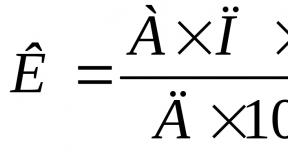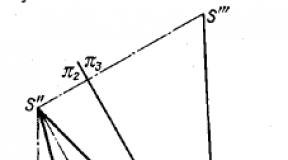Calcium. Calcium and its characteristics Chemical properties of ca
Calcium is located in the fourth large period, the second group, the main subgroup, the element's serial number is 20. According to Mendeleev's periodic table, the atomic weight of calcium is 40.08. The formula of the highest oxide is CaO. Calcium has a Latin name calcium, so the element's atom symbol is Ca.
Characterization of calcium as a simple substance
Under normal conditions, calcium is a silvery-white metal. Having a high chemical activity, the element is able to form many compounds of different classes. The element is of value for technical and industrial chemical syntheses. The metal is widely distributed in the earth's crust: its share is about 1.5%. Calcium belongs to the group of alkaline earth metals: when dissolved in water, it gives alkalis, but in nature it occurs in the form of multiple minerals and. Sea water contains calcium in high concentrations (400 mg/l).
pure sodiumThe characteristics of calcium depend on the structure of its crystal lattice. This element has two types of it: cubic face-centric and volume-centric. The type of bond in the molecule is metallic.
Natural sources of calcium:
- apatite;
- alabaster;
- gypsum;
- calcite;
- fluorite;
- dolomite.
Physical properties of calcium and methods for producing metal
Under normal conditions, calcium is in a solid state of aggregation. The metal melts at 842 °C. Calcium is a good electrical and thermal conductor. When heated, it passes first into a liquid, and then into a vapor state and loses its metallic properties. The metal is very soft and can be cut with a knife. Boils at 1484 °C.
Under pressure, calcium loses its metallic properties and electrical conductivity. But then the metallic properties are restored and the properties of a superconductor appear, several times greater than the rest in their performance.
For a long time it was not possible to obtain calcium without impurities: due to its high chemical activity, this element does not occur in nature in its pure form. The element was discovered at the beginning of the 19th century. Calcium as a metal was first synthesized by the British chemist Humphrey Davy. The scientist discovered the features of the interaction of melts of solid minerals and salts with an electric current. Nowadays, the electrolysis of calcium salts (mixtures of calcium and potassium chlorides, mixtures of calcium fluoride and calcium chloride) remains the most relevant method for producing metal. Calcium is also extracted from its oxide using aluminothermy, a method common in metallurgy.
Chemical properties of calcium
Calcium is an active metal that enters into many interactions. Under normal conditions, it easily reacts, forming the corresponding binary compounds: with oxygen, halogens. Click to learn more about calcium compounds. When heated, calcium reacts with nitrogen, hydrogen, carbon, silicon, boron, phosphorus, sulfur and other substances. In the open air, it instantly interacts with oxygen and carbon dioxide, therefore it becomes covered with a gray coating.
Reacts violently with acids, sometimes igniting. In salts, calcium exhibits interesting properties. For example, cave stalactites and stalagmites are calcium carbonate, gradually formed from water, carbon dioxide and bicarbonate as a result of processes inside groundwater.
Due to its high activity in the normal state, calcium is stored in laboratories in dark sealed glassware under a layer of paraffin or kerosene. A qualitative reaction to the calcium ion is the coloring of the flame in a rich brick-red color.
 Calcium turns the flame red
Calcium turns the flame red
The metal in the composition of compounds can be identified by insoluble precipitates of some salts of the element (fluoride, carbonate, sulfate, silicate, phosphate, sulfite).
The reaction of water with calcium
Calcium is stored in jars under a layer of protective liquid. To conduct, demonstrating how the reaction of water and calcium occurs, you cannot just get the metal and cut off the desired piece from it. Metallic calcium in the laboratory is easier to use in the form of shavings.
If there are no metal shavings, and there are only large pieces of calcium in the bank, pliers or a hammer will be required. The finished piece of calcium of the desired size is placed in a flask or glass of water. Calcium shavings are placed in a dish in a gauze bag.
Calcium sinks to the bottom, and hydrogen evolution begins (first, in the place where the fresh fracture of the metal is located). Gradually, gas is released from the calcium surface. The process resembles rapid boiling, at the same time a precipitate of calcium hydroxide (slaked lime) is formed.
 lime slaking
lime slaking
A piece of calcium floats up, picked up by bubbles of hydrogen. After about 30 seconds, the calcium dissolves and the water turns cloudy white due to the formation of hydroxide slurry. If the reaction is carried out not in a beaker, but in a test tube, heat evolution can be observed: the test tube quickly becomes hot. The reaction of calcium with water does not end with a spectacular explosion, but the interaction of the two substances proceeds violently and looks spectacular. The experience is safe.
If the bag with the remaining calcium is removed from the water and held in the air, then after a while, as a result of the ongoing reaction, strong heating will occur and the remaining in the gauze will boil. If part of the cloudy solution is filtered through a funnel into a beaker, then when carbon monoxide CO₂ is passed through the solution, a precipitate will form. This does not require carbon dioxide - you can blow exhaled air into the solution through a glass tube.
Home / Lectures 1st year / General and organic chemistry / Question 23. Calcium / 2. Physical and chemical properties
physical properties. Calcium is a silvery-white malleable metal that melts at 850°C. C and boils at 1482 degrees. C. It is much harder than the alkali metals.
Chemical properties. Calcium is an active metal. So under normal conditions, it easily interacts with atmospheric oxygen and halogens:
2 Ca + O2 \u003d 2 CaO (calcium oxide);
Ca + Br2 = CaBr2 (calcium bromide).
With hydrogen, nitrogen, sulfur, phosphorus, carbon and other non-metals, calcium reacts when heated:
Ca + H2 = CaH2 (calcium hydride);
3 Ca + N2 = Ca3N2 (calcium nitride);
Ca + S = CaS (calcium sulfide);
3 Ca + 2 P = Ca3P2 (calcium phosphide);
Ca + 2 C \u003d CaC2 (calcium carbide).
Calcium interacts slowly with cold water, and very vigorously with hot water:
Ca + 2 H2O \u003d Ca (OH) 2 + H2.
Calcium can take away oxygen or halogens from oxides and halides of less active metals, i.e. it has reducing properties:
5 Ca + Nb2O5 = CaO + 2 Nb;
- 1. Being in nature
- 3. Receipt
- 4. Application
www.medkurs.ru
Calcium | guide Pesticides.ru
For many people, the knowledge about calcium is limited to the fact that this element is necessary for healthy bones and teeth. Where else it is contained, why it is needed and how necessary, not everyone has an idea. However, calcium is found in many compounds that are familiar to us, both natural and man-made. Chalk and lime, stalactites and stalagmites of caves, ancient fossils and cement, gypsum and alabaster, dairy products and anti-osteoporosis drugs - all this and more is high in calcium.
This element was first obtained by G. Davy in 1808, and at first it was not used very actively. Nevertheless, now this metal is the fifth in the world in terms of production, and the need for it is increasing year by year. The main area of calcium use is the production of building materials and mixtures. However, it is necessary for building not only houses, but also living cells. In the human body, calcium is part of the skeleton, makes muscle contractions possible, ensures blood clotting, regulates the activity of a number of digestive enzymes, and performs other rather numerous functions. It is no less important for other living objects: animals, plants, fungi and even bacteria. At the same time, the need for calcium is quite high, which makes it possible to classify it as a macronutrient.
Calcium (Calcium), Ca is a chemical element of the main subgroup of group II of the periodic system of Mendeleev. Atomic number - 20. Atomic mass - 40.08.
Calcium is an alkaline earth metal. In the free state malleable, rather hard, white. Density refers to light metals.
- Density - 1.54 g / cm3,
- Melting point - +842 ° C,
- Boiling point - +1495 ° C.
Calcium has pronounced metallic properties. In all compounds, the oxidation state is +2.
In air, it is covered with a layer of oxide; when heated, it burns with a reddish, bright flame. It reacts slowly with cold water, and quickly displaces hydrogen from hot water and forms hydroxide. When reacting with hydrogen, it forms hydrides. At room temperature, it reacts with nitrogen to form nitrides. It also easily combines with halogens and sulfur, restores metal oxides when heated.
Calcium is one of the most abundant elements in nature. In the earth's crust, its content is 3% by weight. It occurs in the form of deposits of chalk, limestone, marble (a natural variety of calcium carbonate CaCO3). In large quantities there are deposits of gypsum (CaSO4 x 2h3O), phosphorite (Ca3 (PO4) 2 and various calcium-containing silicates.
Water
. Calcium salts are almost always present in natural water. Of these, only gypsum is slightly soluble in it. With the content of carbon dioxide in water, calcium carbonate goes into solution in the form of bicarbonate Ca(HCO3)2.hard water
. Natural water with a large amount of calcium or magnesium salts is called hard.soft water
. With a low content of these salts or their absence, water is called soft.Soils
. As a rule, soils are adequately provided with calcium. And, since calcium is contained in a larger mass in the vegetative part of plants, its removal with the crop is negligible.Losses of calcium from the soil occur as a result of its leaching by precipitation. This process depends on the granulometric composition of soils, rainfall, plant species, forms and doses of lime and mineral fertilizers. Depending on these factors, calcium losses from the arable layer range from several tens to 200–400 kg/ha or more.
Calcium content in different soil types
Podzolic soils contain 0.73% (of the dry matter of the soil) calcium.
Gray forest - 0.90% calcium.
Chernozems - 1.44% calcium.
Serozems - 6.04% calcium.
In the plant, calcium is in the form of phosphates, sulfates, carbonates, in the form of salts of pectin and oxalic acids. Almost 65% of calcium in plants can be extracted with water. The rest is treated with weak acetic and hydrochloric acids. Most calcium is found in aging cells.
Calcium deficiency symptoms according to: |
|
culture | deficiency symptoms |
General symptoms | Whitening of the apical bud; Whitening of young leaves; The tips of the leaves are bent down; The edges of the leaves curl up; |
Potato | Upper leaves are poorly blooming; The growing point of the stem dies; There is a light stripe on the edges of the leaves, later it darkens; The edges of the leaves are twisted up; |
Cabbage white and cauliflower | On the leaves of young plants, chlorotic spotting (marbling) or white stripes along the edges; In older plants, the leaves curl and burns appear on them; Growth point dies |
Leaf terminal lobes die Flowers fall; A dark spot appears on the fruit at the apex, which increases as the fruit grows (tomato apex rot) |
|
The apical buds die; The edges of young leaves are wrapped up, torn, then die off; The upper parts of the shoots die off; Damage to the tips of the roots; In the pulp of the fruit - brown spots (bitter pitting); The taste of the fruit deteriorates; Decreased marketability of fruits |
Functions of calcium
The effect of this element on plants is multilateral and, as a rule, positive. Calcium:
- Enhances metabolism;
- Plays an important role in the movement of carbohydrates;
- Influences the metamorphoses of nitrogenous substances;
- Accelerates the consumption of seed reserve proteins during germination;
- Plays a role in the process of photosynthesis;
- a strong antagonist of other cations, prevents their excessive entry into plant tissues;
- It affects the physicochemical properties of protoplasm (viscosity, permeability, etc.), and hence the normal course of biochemical processes in the plant;
- Calcium compounds with pectin glue the walls of individual cells together;
- Influences the activity of enzymes.
It should be noted that the effect of calcium compounds (lime) on the activity of enzymes is expressed not only in direct action, but also due to the improvement of the physicochemical properties of the soil and its nutritional regime. In addition, soil liming significantly affects the processes of vitamin biosynthesis.
Lack (deficiency) of calcium in plants
The lack of calcium primarily affects the development of the root system. The formation of root hairs stops on the roots. The outer cells of the root are destroyed.
This symptom manifests itself both with a lack of calcium and with an imbalance in the nutrient solution, that is, the predominance of monovalent sodium, potassium and hydrogen cations in it.
In addition, the presence of nitrate nitrogen in the soil solution enhances the flow of calcium into plant tissues, while ammonia decreases it.
Signs of calcium starvation are expected when the calcium content is less than 20% of the soil cation exchange capacity.
Symptoms. Visually, calcium deficiency is established by the following signs:
- At the roots of plants, damaged brown tips are observed;
- The growth point is deformed and dies;
- Flowers, ovaries and buds fall off;
- Fruits are damaged by necrosis;
- Leaves are chlorotic;
- The apical bud dies, and the growth of the stem stops.
Cabbage, alfalfa, clover are highly sensitive to the presence of calcium. It has been established that these same plants are also characterized by increased sensitivity to soil acidity.
Mineral calcium poisoning results in interveinal chlorosis with whitish necrotic patches. They can be colored or have concentric rings filled with water. Some plants respond to excess calcium by growing leaf rosettes, dying off shoots and falling leaves. Symptoms are similar in appearance to a lack of iron and magnesium.
The source of replenishment of calcium in the soil is lime fertilizers. They are divided into three groups:
- Hard calcareous rocks;
- Soft calcareous rocks;
- Industrial waste with high lime content.
Hard calcareous rocks according to the content of CaO and MgO are divided into:
- limestones (55–56% CaO and up to 0.9% MgO);
- dolomitic limestones (42–55% CaO and up to 9% MgO);
- dolomites (32–30% CaO and 18–20% MgO).
Limestones
- basic lime fertilizers. Contain 75–100% Ca and Mg oxides in terms of CaCO3.Dolomitized limestone
. Contains 79-100% active ingredient (a.i.) in terms of CaCO3. It is recommended in crop rotations with potatoes, legumes, flax, root crops, as well as on heavily podzolized soil types.Marl
. Contains up to 25–15% CaCO3 and impurities in the form of clay with sand up to 20–40%. Acts slowly. Recommended for use on light soils.Chalk
. Contains 90–100% CaCO3. Action is faster than that of limestone. It is a valuable lime fertilizer in finely ground form.burnt lime
(CaO). The content of CaCO3 is over 70%. It is characterized as a strong and fast acting liming material.Slaked lime
(Ca(OH)2). The content of CaCO3 is 35% or more. It is also a strong and fast acting lime fertilizer.Dolomite flour
. The content of CaCO3 and MgCO3 is about 100%. Slower in action than calcareous tuffs. Typically used where magnesium is required.calcareous tuffs
. The content of CaCO3 is 15–96%, impurities are up to 25% clay and sand, 0.1% P2O5. Action is faster than that of limestone.Defecation mud (defecation)
. Consists of CaCO3 and Ca(OH)2. The content of lime on CaO is up to 40%. Nitrogen is also present - 0.5% and P2O5 - 1-2%. This is waste from sugar beet factories. It is recommended for use not only to reduce soil acidity, but also in beet-growing areas on chernozem soils.Shale ash cyclones
. Dry pulverized material. The content of the active substance is 60-70%. Refers to industrial waste.Dust from kilns and cement plants
. The content of CaCO3 must exceed 60%. In practice, it is used in farms located in the immediate vicinity of cement plants.Metallurgical slag
. Used in the regions of the Urals and Siberia. Non-hygroscopic, easy to spray. Must contain at least 80% CaCO3, have a moisture content of not more than 2%. The granulometric composition is important: 70% - less than 0.25 mm, 90% - less than 0.5 mm.organic fertilizers. The content of Ca in terms of CaCO3 is 0.32–0.40%.
Phosphate flour. The calcium content is 22% CaCO3.
Lime fertilizers are used not only to provide soil and plants with calcium. The main purpose of their use is soil liming. This is a method of chemical reclamation. It is aimed at neutralizing excess soil acidity, improving its agrophysical, agrochemical and biological properties, supplying plants with magnesium and calcium, mobilizing and immobilizing macroelements and microelements, creating optimal water-physical, physical, and air conditions for the life of cultivated plants.
Soil liming efficiency
Simultaneously with meeting the need of plants for calcium as an element of mineral nutrition, liming leads to multiple positive changes in soils.
Effect of liming on the properties of some soils
Calcium promotes coagulation of soil colloids and prevents their leaching. This leads to easier soil cultivation and improved aeration.
As a result of liming:
- sandy humus soils increase their water absorption capacity;
- on heavy clay soils, soil aggregates and clods are formed that improve water permeability.
In particular, organic acids are neutralized and H-ions are displaced from the absorbing complex. This leads to the elimination of exchange and reduction of hydrolytic acidity of the soil. At the same time, there is an improvement in the cationic composition of the soil absorbing complex, which occurs due to the change of hydrogen and aluminum ions to calcium and magnesium cations. This increases the degree of saturation of soils with bases and increases the uptake capacity.
The effect of liming on the supply of plants with nitrogen
After liming, the positive agrochemical properties of the soil and its structure can be preserved for several years. This contributes to the creation of favorable conditions for enhancing beneficial microbiological processes to mobilize nutrients. The activity of ammonifiers, nitrifiers, nitrogen-fixing bacteria that live freely in the soil is enhanced.
Liming helps to increase the reproduction of nodule bacteria and improve the supply of nitrogen to the host plant. It has been established that bacterial fertilizers lose their effectiveness on acidic soils.
The effect of liming on the supply of plants with ash elements
Liming contributes to the supply of ash elements to the plant, since the activity of bacteria that decompose organic phosphorus compounds in the soil and promote the transition of iron and aluminum phosphates into calcium phosphate salts available to plants is enhanced. Liming of acidic soils enhances microbiological and biochemical processes, which, in turn, increases the amount of nitrates, as well as assimilable forms of phosphorus and potassium.
The effect of liming on the forms and availability of macronutrients and trace elements
Liming increases the amount of calcium, and when using dolomite flour - magnesium. Simultaneously, the toxic forms of manganese and aluminum become insoluble and pass into the precipitated form. The availability of elements such as iron, copper, zinc, manganese is declining. Nitrogen, sulfur, potassium, calcium, magnesium, phosphorus and molybdenum are becoming more available.
Effect of liming on the action of physiologically acidic fertilizers
Liming increases the effectiveness of physiologically acidic mineral fertilizers, especially ammonia and potash.
The positive effect of physiologically acidic fertilizers fades without lime, and over time can turn into a negative one. So on the fertilized sites, the yields are even less than on the unfertilized ones. The combination of liming with the use of fertilizers increases their effectiveness by 25–50%.
Liming activates enzymatic processes in the soil, which indirectly judge its fertility.
Compiled by: Grigorovskaya P.I.
Page added: 05.12.13 00:40
Last update: 05/22/14 16:25
Literary sources:
Glinka N.L. General chemistry. Textbook for universities. Publisher: L: Chemistry, 1985, p. 731
Mineev V.G. Agrochemistry: Textbook. - 2nd edition, revised and supplemented. - M .: MGU Publishing House, KolosS Publishing House, 2004. - 720 p., L. ill.: ill. – (Classic university textbook).
Petrov B.A., Seliverstov N.F. Mineral nutrition of plants. Reference manual for students and gardeners. Yekaterinburg, 1998. 79 p.
Encyclopedia for children. Volume 17. Chemistry. / Head. ed. V.A. Volodin. - M.: Avanta +, 2000. - 640 p., ill.
Yagodin B.A., Zhukov Yu.P., Kobzarenko V.I. Agrochemistry / Edited by B.A. Yagodina. - M.: Kolos, 2002. - 584 p.: silt (Textbooks and teaching aids for students of higher educational institutions).
Images (remastered):
20 Ca Calcium, under license CC BY
Calcium deficiency in wheat, by CIMMYT, licensed under CC BY-NC-SA
www.pesticidy.ru
Calcium and its role for humanity - Chemistry
Calcium and its role for humanity
Introduction
Being in nature
Receipt
Physical Properties
Chemical properties
The use of calcium compounds
Biological role
Conclusion
Bibliography
Introduction
Calcium is an element of the main subgroup of the second group, the fourth period of the periodic system of chemical elements of D. I. Mendeleev, with atomic number 20. It is denoted by the symbol Ca (lat. Calcium). The simple substance calcium (CAS number: 7440-70-2) is a soft, reactive, silvery-white alkaline earth metal.
Despite the ubiquity of element #20, even chemists have not seen elemental calcium. But this metal, both externally and in behavior, is completely different from alkali metals, contact with which is fraught with the danger of fires and burns. It can be safely stored in air, it does not ignite from water. The mechanical properties of elemental calcium do not make it a "black sheep" in the family of metals: calcium surpasses many of them in strength and hardness; it can be turned on a lathe, drawn into a wire, forged, pressed.
And yet, elemental calcium is almost never used as a structural material. He's too active for that. Calcium easily reacts with oxygen, sulfur, halogens. Even with nitrogen and hydrogen, under certain conditions, it reacts. The environment of carbon oxides, inert for most metals, is aggressive for calcium. It burns in an atmosphere of CO and CO2.
History and origin of the name
The name of the element comes from lat. calx (in the genitive case calcis) -- "lime", "soft stone". It was proposed by the English chemist Humphrey Davy, who in 1808 isolated calcium metal by the electrolytic method. Davy electrolyzed a mixture of wet slaked lime with mercury oxide HgO on a platinum plate, which was the anode. A platinum wire immersed in liquid mercury served as the cathode. As a result of electrolysis, calcium amalgam was obtained. Having driven away mercury from it, Davy received a metal called calcium.
Calcium compounds - limestone, marble, gypsum (as well as lime - a product of burning limestone) have been used in construction for several millennia ago. Until the end of the 18th century, chemists considered lime to be a simple body. In 1789, A. Lavoisier suggested that lime, magnesia, barite, alumina and silica are complex substances.
Being in nature
Due to the high chemical activity of calcium in the free form in nature is not found.
Calcium accounts for 3.38% of the mass of the earth's crust (5th place in abundance after oxygen, silicon, aluminum and iron).
Isotopes. Calcium occurs in nature in the form of a mixture of six isotopes: 40Ca, 42Ca, 43Ca, 44Ca, 46Ca and 48Ca, among which the most common - 40Ca - is 96.97%.
Of the six naturally occurring calcium isotopes, five are stable. The sixth 48Ca isotope, the heaviest of the six and very rare (its isotopic abundance is only 0.187%), was recently discovered to undergo double beta decay with a half-life of 5.3×1019 years.
in rocks and minerals. Most of the calcium is contained in the composition of silicates and aluminosilicates of various rocks (granites, gneisses, etc.), especially in feldspar - anorthite Ca.
In the form of sedimentary rocks, calcium compounds are represented by chalk and limestone, consisting mainly of the mineral calcite (CaCO3). The crystalline form of calcite, marble, is much less common in nature.
Calcium minerals such as calcite CaCO3, anhydrite CaSO4, alabaster CaSO4 0.5h3O and gypsum CaSO4 2h3O, fluorite CaF2, apatites Ca5(PO4)3(F,Cl,OH), dolomite MgCO3 CaCO3 are quite widespread. The presence of calcium and magnesium salts in natural water determines its hardness.
Calcium, which migrates vigorously in the earth's crust and accumulates in various geochemical systems, forms 385 minerals (fourth in terms of the number of minerals).
Migration in the earth's crust. In the natural migration of calcium, a significant role is played by the “carbonate equilibrium”, associated with the reversible reaction of the interaction of calcium carbonate with water and carbon dioxide with the formation of soluble bicarbonate:
CaCO3 + h3O + CO2 - Ca (HCO3) 2 - Ca2+ + 2HCO3-
(the equilibrium shifts to the left or right depending on the concentration of carbon dioxide).
biogenic migration. In the biosphere, calcium compounds are found in almost all animal and plant tissues (see also below). A significant amount of calcium is part of living organisms. So, hydroxyapatite Ca5 (PO4) 3OH, or, in another way, 3Ca3 (PO4) 2 Ca (OH) 2 is the basis of the bone tissue of vertebrates, including humans; shells and shells of many invertebrates, egg shells, etc. are composed of calcium carbonate CaCO3. In living tissues of humans and animals, 1.4-2% Ca (by mass fraction); in a human body weighing 70 kg, the calcium content is about 1.7 kg (mainly in the composition of the intercellular substance of bone tissue).
Receipt
Free metallic calcium is obtained by electrolysis of a melt consisting of CaCl2 (75-80%) and KCl or from CaCl2 and CaF2, as well as by aluminothermic reduction of CaO at 1170-1200 °C:
4CaO + 2Al = CaAl2O4 + 3Ca.
Physical Properties
Calcium metal exists in two allotropic modifications. Up to 443 °C, stable?-Ca with a cubic face-centered lattice (parameter a = 0.558 nm), above stable?-Ca with a cubic body-centered lattice of the type?-Fe (parameter a = 0.448 nm). Standard enthalpy? H0 transition? > ? is 0.93 kJ/mol.
Chemical properties
Calcium is a typical alkaline earth metal. The chemical activity of calcium is high, but lower than that of all other alkaline earth metals. It readily reacts with oxygen, carbon dioxide and moisture in the air, due to which the surface of calcium metal is usually dull gray, so calcium is usually stored in the laboratory, like other alkaline earth metals, in a tightly closed jar under a layer of kerosene or liquid paraffin.
In the series of standard potentials, calcium is located to the left of hydrogen. The standard electrode potential of the Ca2+/Ca0 pair is ?2.84 V, so that calcium actively reacts with water, but without ignition:
Ca + 2H2O \u003d Ca (OH) 2 + H2 ^ + Q.
With active non-metals (oxygen, chlorine, bromine), calcium reacts under normal conditions:
2Ca + O2 = 2CaO, Ca + Br2 = CaBr2.
When heated in air or oxygen, calcium ignites. With less active non-metals (hydrogen, boron, carbon, silicon, nitrogen, phosphorus and others), calcium interacts when heated, for example:
Ca + H2 = CaH2, Ca + 6B = CaB6,
3Ca + N2 = Ca3N2, Ca + 2C = CaC2,
3Ca + 2P = Ca3P2 (
calcium phosphide), calcium phosphides of CaP and CaP5 compositions are also known;
2Ca + Si = Ca2Si
(calcium silicide), calcium silicides of compositions CaSi, Ca3Si4 and CaSi2 are also known.
The course of the above reactions, as a rule, is accompanied by the release of a large amount of heat (that is, these reactions are exothermic). In all compounds with non-metals, the oxidation state of calcium is +2. Most of the calcium compounds with non-metals are easily decomposed by water, for example:
CaH2 + 2H2O \u003d Ca (OH) 2 + 2H2 ^,
Ca3N2 + 3H2O = 3Ca(OH)2 + 2Nh4^.
The Ca2+ ion is colorless. When soluble calcium salts are added to the flame, the flame turns brick red.
Calcium salts such as CaCl2 chloride, CaBr2 bromide, CaI2 iodide and Ca(NO3)2 nitrate are highly soluble in water. CaF2 fluoride, CaCO3 carbonate, CaSO4 sulfate, Ca3(PO4)2 orthophosphate, CaC2O4 oxalate and some others are insoluble in water.
Of great importance is the fact that, unlike calcium carbonate CaCO3, acidic calcium carbonate (hydrocarbonate) Ca(HCO3)2 is soluble in water. In nature, this leads to the following processes. When cold rain or river water, saturated with carbon dioxide, penetrates underground and falls on limestones, their dissolution is observed:
CaCO3 + CO2 + H2O \u003d Ca (HCO3) 2.
In the same places where water saturated with calcium bicarbonate comes to the surface of the earth and is heated by the sun's rays, the reverse reaction occurs:
Ca(HCO3)2 = CaCO3 + CO2^ + H2O.
So in nature there is a transfer of large masses of substances. As a result, huge gaps can form underground, and beautiful stone "icicles" - stalactites and stalagmites - form in the caves.
The presence of dissolved calcium bicarbonate in water largely determines the temporary hardness of water. It is called temporary because when water is boiled, the bicarbonate decomposes, and CaCO3 precipitates. This phenomenon leads, for example, to the fact that scale forms in the kettle over time.
Applications of metallic calcium
The main use of calcium metal is as a reducing agent in the production of metals, especially nickel, copper and stainless steel. Calcium and its hydride are also used to obtain hard-to-recover metals such as chromium, thorium and uranium. Alloys of calcium with lead are used in batteries and bearing alloys. Calcium granules are also used to remove traces of air from electrovacuum devices.
Metalthermy
Pure metallic calcium is widely used in metallothermy to obtain rare metals.
Alloying
Pure calcium is used to alloy lead, which is used for the manufacture of battery plates, maintenance-free starter lead-acid batteries with low self-discharge. Also, metallic calcium is used for the production of high-quality calcium babbits BKA.
Nuclear fusion
The 48Ca isotope is the most effective and widely used material for the production of superheavy elements and the discovery of new elements in the periodic table. For example, in the case of using 48Ca ions to produce superheavy elements in accelerators, the nuclei of these elements are formed hundreds and thousands of times more efficiently than when using other "projectiles" (ions).
The use of calcium compounds
calcium hydride. By heating calcium in a hydrogen atmosphere, Cah3 (calcium hydride) is obtained, which is used in metallurgy (metallothermy) and in the production of hydrogen in the field.
Optical and laser materials. Calcium fluoride (fluorite) is used in the form of single crystals in optics (astronomical objectives, lenses, prisms) and as a laser material. Calcium tungstate (scheelite) in the form of single crystals is used in laser technology, and also as a scintillator.
calcium carbide. Calcium carbide CaC2 is widely used to obtain acetylene and to reduce metals, as well as in the production of calcium cyanamide (by heating calcium carbide in nitrogen at 1200 ° C, the reaction is exothermic, carried out in cyanamide furnaces).
Chemical current sources. Calcium, as well as its alloys with aluminum and magnesium, are used in reserve thermal electric batteries as an anode (for example, a calcium-chromate element). Calcium chromate is used in such batteries as the cathode. A feature of such batteries is an extremely long shelf life (decades) in a usable condition, the ability to operate in any conditions (space, high pressures), high specific energy by weight and volume. The disadvantage is the short duration. Such batteries are used where it is necessary to create colossal electric power for a short time (ballistic missiles, some spacecraft, etc.).
Refractory materials. Calcium oxide, both in free form and as part of ceramic mixtures, is used in the production of refractory materials.
Medicines. Calcium compounds are widely used as an antihistamine.
Calcium chloride
Calcium gluconate
calcium glycerophosphate
In addition, calcium compounds are introduced into preparations for the prevention of osteoporosis, into vitamin complexes for pregnant women and the elderly.
Biological role
Calcium is a common macronutrient in plants, animals and humans. In humans and other vertebrates, most of it is found in the skeleton and teeth in the form of phosphates. The skeletons of most groups of invertebrates (sponges, coral polyps, mollusks, etc.) are composed of various forms of calcium carbonate (lime). Calcium ions are involved in the processes of blood coagulation, as well as in maintaining a constant osmotic pressure of the blood. Calcium ions also serve as one of the universal second messengers and regulate a variety of intracellular processes - muscle contraction, exocytosis, including the secretion of hormones and neurotransmitters, etc. The calcium concentration in the cytoplasm of human cells is about 10–7 mol, in intercellular fluids about 10 ?3 mol.
The need for calcium depends on age. For adults, the required daily allowance is from 800 to 1000 milligrams (mg), and for children from 600 to 900 mg, which is very important for children due to the intensive growth of the skeleton. Most of the calcium that enters the human body with food is found in dairy products, the remaining calcium is found in meat, fish, and some plant foods (legumes are especially rich). Absorption occurs both in the large and small intestines and is facilitated by an acidic environment, vitamin D and vitamin C, lactose, and unsaturated fatty acids. The role of magnesium in calcium metabolism is also important, with its deficiency, calcium is “washed out” of the bones and deposited in the kidneys (kidney stones) and muscles.
Assimilation of calcium is prevented by aspirin, oxalic acid, estrogen derivatives. Combining with oxalic acid, calcium gives water-insoluble compounds that are components of kidney stones.
Due to the large number of processes associated with calcium, the content of calcium in the blood is precisely regulated, and with proper nutrition, deficiency does not occur. Prolonged absence from the diet can cause cramps, joint pain, drowsiness, growth defects, and constipation. A deeper deficiency leads to permanent muscle cramps and osteoporosis. Abuse of coffee and alcohol can be the causes of calcium deficiency, as part of it is excreted in the urine.
Excessive doses of calcium and vitamin D can cause hypercalcemia, followed by intense calcification of bones and tissues (mainly affecting the urinary system). A prolonged excess disrupts the functioning of muscle and nerve tissues, increases blood clotting and reduces the absorption of zinc by bone cells. The maximum daily safe dose for an adult is 1500 to 1800 milligrams.
Products Calcium, mg/100 g
Sesame 783
Nettle 713
Mallow forest 505
Plantain big 412
Galinsoga 372
Sardines in oil 330
Budra ivy 289
Dog rosehip 257
Almond 252
Plantain lanceolate. 248
Hazelnut 226
Amaranth seed 214
Watercress 214
Soy beans dry 201
Children under 3 years - 600 mg.
Children 4 to 10 years old - 800 mg.
Children 10 to 13 years old - 1000 mg.
Adolescents 13 to 16 years old - 1200 mg.
Youth 16 and older - 1000 mg.
Adults 25 to 50 years old - 800 to 1200 mg.
Pregnant and breastfeeding women - 1500 to 2000 mg.
Conclusion
Calcium is one of the most abundant elements on earth. There is a lot of it in nature: mountain ranges and clay rocks are formed from calcium salts, it is found in sea and river water, and is part of plant and animal organisms.
Calcium constantly surrounds the townspeople: almost all the main building materials - concrete, glass, brick, cement, lime - contain this element in significant quantities.
Naturally, having such chemical properties, calcium cannot be found in nature in a free state. But calcium compounds - both natural and artificial - have become of paramount importance.
Bibliography
1. Editorial board: Knunyants I. L. (editor-in-chief) Chemical Encyclopedia: in 5 volumes - Moscow: Soviet Encyclopedia, 1990. - T. 2. - S. 293. - 671 p.
2. Doronin. N. A. Kaltsy, Goshimizdat, 1962. 191 pages with illustrations.
3. Dotsenko VA. - Therapeutic and preventive nutrition. - Q. nutrition, 2001 - N1-p.21-25
4. Bilezikian J. P. Calcium and bone metabolism // In: K. L. Becker, ed.
www.e-ng.ru
world of science
Calcium is a metal element of the main subgroup II of group 4 of the period of the periodic system of chemical elements. It belongs to the family of alkaline earth metals. The outer energy level of the calcium atom contains 2 paired s-electrons
Which he is able to give energetically during chemical interactions. Thus, Calcium is a reducing agent and in its compounds has an oxidation state of +2. In nature, calcium occurs only in the form of salts. The mass fraction of calcium in the earth's crust is 3.6%. The main natural calcium mineral is calcite CaCO3 and its varieties - limestone, chalk, marble. There are also living organisms (for example, corals), the backbone of which consists mainly of calcium carbonate. Also important calcium minerals are dolomite CaCO3 MgCO3, fluorite CaF2, gypsum CaSO4 2h3O, apatite, feldspar, etc. Calcium plays an important role in the life of living organisms. The mass fraction of calcium in the human body is 1.4-2%. It is part of the teeth, bones, other tissues and organs, participates in the process of blood coagulation, stimulates cardiac activity. To provide the body with a sufficient amount of calcium, it is imperative to consume milk and dairy products, green vegetables, fish. The simple substance calcium is a typical silver-white metal. It is quite hard, plastic, has a density of 1.54 g/cm3 and a melting point of 842? C. Chemically, calcium is very active. Under normal conditions, it easily interacts with oxygen and moisture in the air, so it is stored in hermetically sealed vessels. When heated in air, calcium ignites and forms an oxide: 2Ca + O2 = 2CaO. Calcium reacts with chlorine and bromine when heated, and with fluorine even in the cold. The products of these reactions are the corresponding halides, for example: Ca + Cl2 = CaCl2. When calcium is heated with sulfur, calcium sulfide is formed: Ca + S = CaS. Calcium can also react with other non-metals. Interaction with water leads to the formation of poorly soluble calcium hydroxide and the evolution of gaseous hydrogen : Ca + 2h3O = Ca (OH) 2 + h3. Calcium metal is widely used. It is used as a rozkisnik in the manufacture of steels and alloys, as a reducing agent for the production of some refractory metals.
Calcium is obtained by electrolysis of a calcium chloride melt. Thus, calcium was first obtained in 1808 by Humphry Davy.
worldofscience.ru
Calcium is a chemical element of group II with atomic number 20 in the periodic system, denoted by the symbol Ca (lat. Calcium). Calcium is a soft, silvery-gray alkaline earth metal.
20 element of the periodic table The name of the element comes from lat. calx (in the genitive case calcis) - "lime", "soft stone". It was proposed by the English chemist Humphry Davy, who isolated metallic calcium in 1808.
Calcium compounds - limestone, marble, gypsum (as well as lime - a product of burning limestone) have been used in construction for several millennia ago.
Calcium is one of the most abundant elements on earth. Calcium compounds are found in almost all animal and plant tissues. It accounts for 3.38% of the mass of the earth's crust (5th place in abundance after oxygen, silicon, aluminum and iron).
Finding calcium in nature
Due to the high chemical activity of calcium in the free form in nature is not found.
Calcium accounts for 3.38% of the mass of the earth's crust (5th place in abundance after oxygen, silicon, aluminum and iron). The content of the element in sea water is 400 mg/l.
isotopes
Calcium occurs in nature in the form of a mixture of six isotopes: 40Ca, 42Ca, 43Ca, 44Ca, 46Ca and 48Ca, among which the most common - 40Ca - is 96.97%. Calcium nuclei contain the magic number of protons: Z = 20. Isotopes
40
20
Ca20 and
48
20
Ca28 are two of the five doubly magic number nuclei found in nature.
Of the six naturally occurring calcium isotopes, five are stable. The sixth 48Ca isotope, the heaviest of the six and very rare (its isotopic abundance is only 0.187%), undergoes double beta decay with a half-life of 1.6 1017 years.
In rocks and minerals
Most calcium is contained in the composition of silicates and aluminosilicates of various rocks (granites, gneisses, etc.), especially in feldspar - anorthite Ca.
In the form of sedimentary rocks, calcium compounds are represented by chalk and limestone, consisting mainly of the mineral calcite (CaCO3). The crystalline form of calcite, marble, is much less common in nature.
Calcium minerals such as calcite CaCO3, anhydrite CaSO4, alabaster CaSO4 0.5H2O and gypsum CaSO4 2H2O, fluorite CaF2, apatites Ca5(PO4)3(F,Cl,OH), dolomite MgCO3 CaCO3 are quite widespread. The presence of calcium and magnesium salts in natural water determines its hardness.
Calcium, which migrates vigorously in the earth's crust and accumulates in various geochemical systems, forms 385 minerals (fourth in terms of the number of minerals).
The biological role of calcium
Calcium is a common macronutrient in plants, animals and humans. In humans and other vertebrates, most of it is in the skeleton and teeth. Calcium is found in bones in the form of hydroxyapatite. The "skeletons" of most groups of invertebrates (sponges, coral polyps, mollusks, etc.) consist of various forms of calcium carbonate (lime). Calcium ions are involved in blood coagulation processes, and also serve as one of the universal second messengers inside cells and regulate a variety of intracellular processes - muscle contraction, exocytosis, including the secretion of hormones and neurotransmitters. The concentration of calcium in the cytoplasm of human cells is about 10−4 mmol/l, in intercellular fluids about 2.5 mmol/l.
The need for calcium depends on age. For adults aged 19-50 years and children aged 4-8 inclusive, the daily requirement (RDA) is 1000 mg (contained in approximately 790 ml of milk with a fat content of 1%), and for children aged 9 to 18 years inclusive - 1300 mg per day (contained in approximately 1030 ml of milk with a fat content of 1%). In adolescence, adequate calcium intake is very important due to the intensive growth of the skeleton. However, according to research in the US, only 11% of girls and 31% of boys aged 12-19 achieve their needs. In a balanced diet, most of the calcium (about 80%) enters the child's body with dairy products. The remaining calcium comes from cereals (including whole grain bread and buckwheat), legumes, oranges, greens, nuts. Dairy products based on milk fat (butter, cream, sour cream, cream-based ice cream) contain practically no calcium. The more milk fat in a dairy product, the less calcium it contains. Calcium absorption in the intestine occurs in two ways: transcellular (transcellular) and intercellular (paracellular). The first mechanism is mediated by the action of the active form of vitamin D (calcitriol) and its intestinal receptors. It plays a big role in low to moderate calcium intake. With a higher calcium content in the diet, intercellular absorption begins to play the main role, which is associated with a large calcium concentration gradient. Due to the transcellular mechanism, calcium is absorbed to a greater extent in the duodenum (due to the highest concentration of receptors in calcitriol there). Due to intercellular passive transfer, calcium absorption is most active in all three sections of the small intestine. Calcium absorption is paracellularly promoted by lactose (milk sugar).
Calcium absorption is hindered by some animal fats (including cow's milk fat and beef fat, but not lard) and palm oil. The palmitic and stearic fatty acids contained in such fats are cleaved off during digestion in the intestines and, in the free form, firmly bind calcium, forming calcium palmitate and calcium stearate (insoluble soaps). In the form of this soap with a chair, both calcium and fat are lost. This mechanism is responsible for decreased calcium absorption, reduced bone mineralization, and reduced indirect measures of bone strength in infants with palm oil (palm olein) based infant formula. In these children, the formation of calcium soaps in the intestines is associated with hardening of the stool, a decrease in its frequency, as well as more frequent regurgitation and colic.
The concentration of calcium in the blood, due to its importance for a large number of vital processes, is precisely regulated, and with proper nutrition and sufficient intake of low-fat dairy products and vitamin D, deficiency does not occur. Prolonged deficiency of calcium and/or vitamin D in the diet leads to an increased risk of osteoporosis and causes rickets in infancy.
Excessive doses of calcium and vitamin D can cause hypercalcemia. The maximum safe dose for adults aged 19 to 50 inclusive is 2500 mg per day (about 340 g of Edam cheese).
CALCIUM (Latin Calcium), Ca, a chemical element of group II of the short form (2nd group of the long form) of the periodic system; refers to alkaline earth metals; atomic number 20; atomic mass 40.078. In nature, there are 6 stable isotopes: 40 Ca (96.941%), 42 Ca (0.647%), 43 Ca (0.135%), 44 Ca (2.086%), 46 Ca (0.004%), 48 Ca (0.187%); artificially obtained radioisotopes with mass numbers 34-54.
History reference. Many natural calcium compounds were known in ancient times and were widely used in construction (for example, gypsum, lime, marble). Metallic calcium was first isolated by G. Davy in 1808 during the electrolysis of a mixture of CaO and HgO oxides and subsequent decomposition of the formed calcium amalgam. The name comes from the Latin calx (genitive calcis) - lime, soft stone.
Distribution in nature. The calcium content in the earth's crust is 3.38% by mass. Due to its high chemical activity, it does not occur in the free state. The most common minerals are anorthite Ca, anhydrite CaSO 4, apatite Ca 5 (PO 4) 3 (F, Cl, OH), gypsum CaSO 4 2H 2 O, calcite and aragonite CaCO 3, perovskite CaTiO 3, fluorite CaF 2, scheelite CaWO four . Calcium minerals are part of sedimentary (for example, limestone), igneous and metamorphic rocks. Calcium compounds are found in living organisms: they are the main components of the bone tissues of vertebrates (hydroxyapatite, fluorapatite), coral skeletons, mollusk shells (calcium carbonate and phosphates), etc. The presence of Ca 2+ ions determines the hardness of water.
Properties. The configuration of the outer electron shell of the calcium atom is 4s 2 ; in compounds it exhibits an oxidation state of +2, rarely +1; Pauling electronegativity 1.00, atomic radius 180 pm, Ca 2+ ion radius 114 pm (coordination number 6). calcium is a silvery-white soft metal; up to 443 °С, the modification with a cubic face-centered crystal lattice is stable, above 443 °С - with a cubic body-centered lattice; t pl 842°С, t kip 1484 °С, density 1550 kg/m3; thermal conductivity 125.6 W/(m K).
Calcium is a metal of high chemical activity (stored in hermetically sealed vessels or under a layer of mineral oil). Under normal conditions, it easily interacts with oxygen (calcium oxide CaO is formed), when heated - with hydrogen (CaH 2 hydride), halogens (calcium halides), boron (CaB 6 boride), carbon (calcium carbide CaC 2), silicon (Ca silicides 2 Si, CaSi, CaSi 2, Ca 3 Si 4), nitrogen (Ca 3 N 2 nitride), phosphorus (Ca 3 P 2, CaP, CaP 5 phosphides), chalcogens (CaX chalcogenides, where X is S, Se, Those). Calcium interacts with other metals (Li, Cu, Ag, Au, Mg, Zn, Al, Pb, Sn, etc.) to form intermetallic compounds. Metallic calcium reacts with water to form calcium hydroxide Ca(OH) 2 and H 2 . Vigorously interacts with most acids, forming the corresponding salts (for example, calcium nitrate, calcium sulfate, calcium phosphates). It dissolves in liquid ammonia to form a dark blue solution with metallic conductivity. When ammonia evaporates, ammonia is released from such a solution. Gradually, calcium reacts with ammonia to form the amide Ca(NH 2) 2 . It forms various complex compounds, complexes with oxygen-containing polydentate ligands, for example Ca complexonates, are of the greatest importance.
Biological role. Calcium refers to biogenic elements. The daily human need for calcium is about 1 g. In living organisms, calcium ions are involved in the processes of muscle contraction and the transmission of nerve impulses.
Receipt. Calcium metal is obtained by electrolytic and metallothermic methods. The electrolytic method is based on the electrolysis of molten calcium chloride with a touch cathode or a liquid copper-calcium cathode. Calcium is distilled off from the resulting copper-calcium alloy at a temperature of 1000-1080 °C and a pressure of 13-20 kPa. The metallothermic method is based on the reduction of calcium from its oxide with aluminum or silicon at 1100-1200 °C. This produces aluminate or calcium silicate, as well as gaseous calcium, which is then condensed. World production of calcium compounds and materials containing calcium, about 1 billion tons/year (1998).
Application. Calcium is used as a reducing agent in the production of many metals (Rb, Cs, Zr, Hf, V, etc.). Calcium silicides, as well as calcium alloys with sodium, zinc and other metals, are used as deoxidizers and desulfurizers for some alloys and oil, for purifying argon from oxygen and nitrogen, and as a gas absorber in vacuum devices. CaCl 2 chloride is used as a drying agent in chemical synthesis, gypsum is used in medicine. Calcium silicates are the main components of cement.
Lit .: Rodyakin VV Calcium, its compounds and alloys. M., 1967; Spitsyn V.I., Martynenko L.I. Inorganic chemistry. M., 1994. Part 2; Inorganic Chemistry / Edited by Yu. D. Tretyakov. M., 2004. T. 2.
L. N. Komissarova, M. A. Ryumin.
Natural calcium compounds (chalk, marble, limestone, gypsum) and their simplest processing products (lime) have been known to people since ancient times. In 1808, the English chemist Humphry Davy electrolyzed wet slaked lime (calcium hydroxide) with a mercury cathode and obtained calcium amalgam (calcium-mercury alloy). From this alloy, having driven away mercury, Davy obtained pure calcium.
He also proposed the name of a new chemical element, from the Latin "calx" denoting the name of limestone, chalk and other soft stones.
Being in nature and getting:
Calcium is the fifth most abundant element in the earth's crust (more than 3%), forms many rocks, many of which are based on calcium carbonate. Some of these rocks are of organic origin (shell rock), showing the important role of calcium in wildlife. Natural calcium is a mixture of 6 isotopes with mass numbers from 40 to 48, with 40 Ca accounting for 97% of the total. Other calcium isotopes have also been obtained by nuclear reactions, for example, radioactive 45 Ca.
To obtain a simple substance of calcium, electrolysis of melts of its salts or aluminothermy is used:
4CaO + 2Al \u003d Ca (AlO 2) 2 + 3Ca
Physical properties:
A silver-gray metal with a face-centered cubic lattice, much harder than the alkali metals. Melting point 842°C, boiling point 1484°C, density 1.55 g/cm 3 . At high pressures and temperatures, about 20 K passes into the state of a superconductor.
Chemical properties:
Calcium is not as active as the alkali metals, yet it must be stored under a layer of mineral oil or in tightly sealed metal drums. Already at ordinary temperature, it reacts with oxygen and nitrogen in the air, as well as with water vapor. When heated, it burns in air with a red-orange flame, forming oxide with an admixture of nitrides. Like magnesium, calcium continues to burn in an atmosphere of carbon dioxide. When heated, it reacts with other non-metals, forming compounds that are not always obvious in composition, for example:
Ca + 6B = CaB 6 or Ca + P => Ca 3 P 2 (also CaP or CaP 5)
In all its compounds, calcium has an oxidation state of +2.
The most important connections:
Calcium oxide CaO- ("quicklime") a white substance, an alkaline oxide, reacts vigorously with water ("extinguished") turning into hydroxide. Obtained by thermal decomposition of calcium carbonate.
Calcium hydroxide Ca(OH) 2- ("slaked lime") white powder, slightly soluble in water (0.16g/100g), strong alkali. A solution ("lime water") is used to detect carbon dioxide.
Calcium carbonate CaCO 3- the basis of most natural calcium minerals (chalk, marble, limestone, shell rock, calcite, Icelandic spar). In its pure form, the substance is white or colorless. crystals, When heated (900-1000 C) decomposes, forming calcium oxide. Not p-rim, reacts with acids, is able to dissolve in water saturated with carbon dioxide, turning into bicarbonate: CaCO 3 + CO 2 + H 2 O \u003d Ca (HCO 3) 2. The reverse process leads to the formation of calcium carbonate deposits, in particular formations such as stalactites and stalagmites.
It occurs in nature also in the composition of dolomite CaCO 3 *MgCO 3
Calcium sulfate CaSO 4- a white substance, in nature CaSO 4 * 2H 2 O ("gypsum", "selenite"). The latter, when heated carefully (180 C), turns into CaSO 4 * 0.5H 2 O ("burnt gypsum", "alabaster") - a white powder, when mixed with water, again forming CaSO 4 * 2H 2 O in the form of a solid, strong enough material. Slightly soluble in water, in excess of sulfuric acid it can dissolve, forming hydrosulfate.
Calcium phosphate Ca 3 (PO 4) 2- ("phosphorite"), insoluble, under the action of strong acids it passes into more soluble calcium hydro- and dihydrogen phosphates. Feedstock for the production of phosphorus, phosphoric acid, phosphate fertilizers. Calcium phosphates are also part of apatites, natural compounds with the approximate formula Ca 5 3 Y, where Y = F, Cl, or OH, respectively, fluorine, chlorine, or hydroxyapatite. Along with phosphorite, apatites are part of the bone skeleton of many living organisms, incl. and a person.
Calcium fluoride CaF 2 - (natural:"fluorite", "fluorspar"), insoluble in white. Natural minerals have a variety of colors due to impurities. Glows in the dark when heated and when exposed to UV radiation. Increases the fluidity ("fusibility") of slags in the production of metals, which is the reason for its use as a flux.
Calcium chloride CaCl 2- colorless crist. in-in well r-rimoe in water. Forms hydrated CaCl 2 *6H 2 O. Anhydrous ("fused") calcium chloride is a good drying agent.
Calcium nitrate Ca(NO 3) 2- ("calcium nitrate") colorless. crist. in-in well r-rimoe in water. A component of pyrotechnic compositions that gives the flame a red-orange color.
Calcium carbide CaС 2- reacts with water, forming acetylene, for example: CaС 2 + H 2 O \u003d C 2 H 2 + Ca (OH) 2
Application:
Metallic calcium is used as a strong reducing agent in the production of some hard-to-recover metals ("calcium term"): chromium, rare earth elements, thorium, uranium, etc. In the metallurgy of copper, nickel, special steels and bronzes, calcium and its alloys are used to remove harmful impurities of sulfur, phosphorus, excess carbon.
Calcium is also used to bind small amounts of oxygen and nitrogen in the production of high vacuum and purification of inert gases.
Neutron-excess ions 48 Ca are used for the synthesis of new chemical elements, such as element No. 114, . Another isotope of calcium, 45 Ca, is used as a radioactive tracer in studies of the biological role of calcium and its migration in the environment.
The main field of application of numerous calcium compounds is the production of building materials (cement, building mixtures, drywall, etc.).
Calcium is one of the macronutrients in the composition of living organisms, forming compounds necessary for building both the internal skeleton of vertebrates and the external skeleton of many invertebrates, egg shells. Calcium ions are also involved in the regulation of intracellular processes, cause blood clotting. Lack of calcium in childhood leads to rickets, in the elderly - to osteoporosis. Dairy products, buckwheat, nuts serve as a source of calcium, and vitamin D contributes to its absorption. In case of calcium deficiency, various preparations are used: calcex, calcium chloride solution, calcium gluconate, etc.
The mass fraction of calcium in the human body is 1.4-1.7%, the daily requirement is 1-1.3 g (depending on age). Excess calcium intake can lead to hypercalcemia - the deposition of its compounds in the internal organs, the formation of blood clots in the blood vessels. Sources:
Calcium (element) // Wikipedia. URL: http://ru.wikipedia.org/wiki/Calcium (date of access: 3.01.2014).
Popular library of chemical elements: Calcium. // URL: http://n-t.ru/ri/ps/pb020.htm (3.01.2014).



















